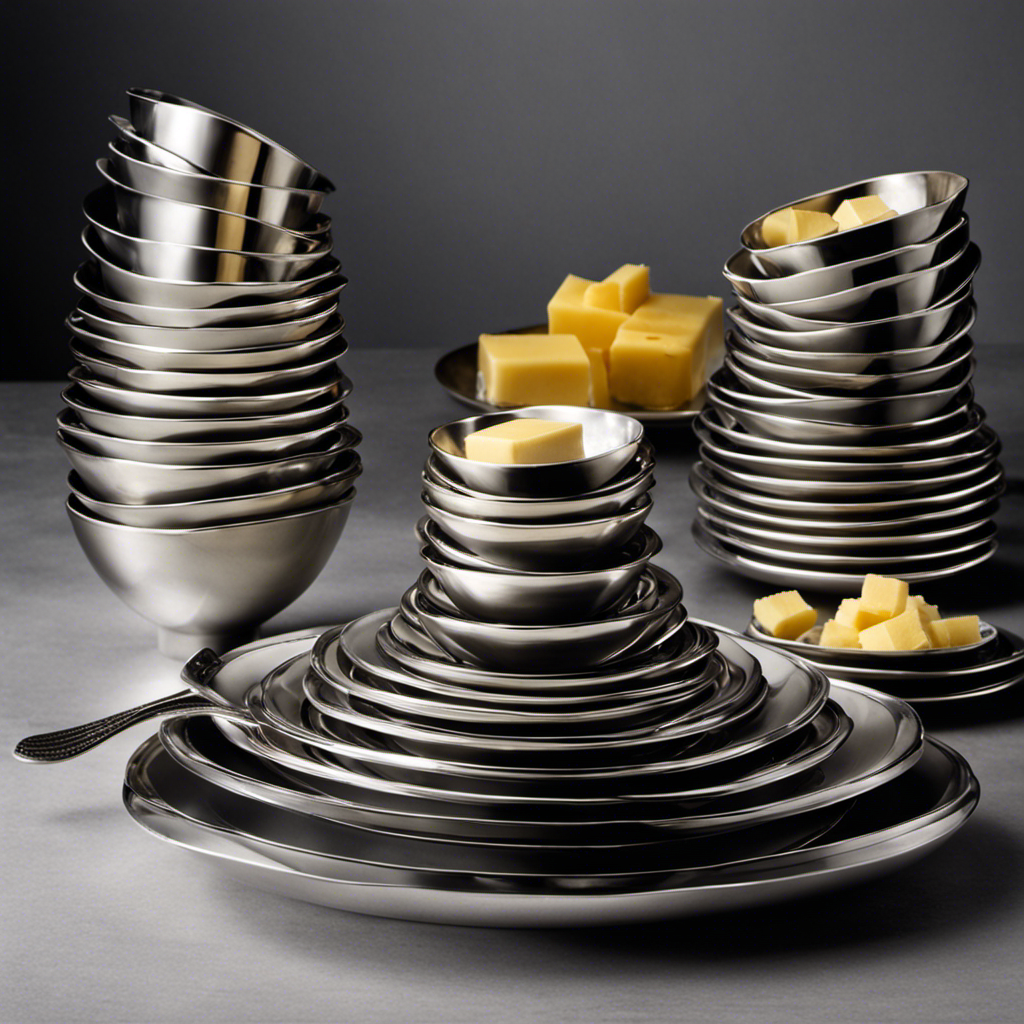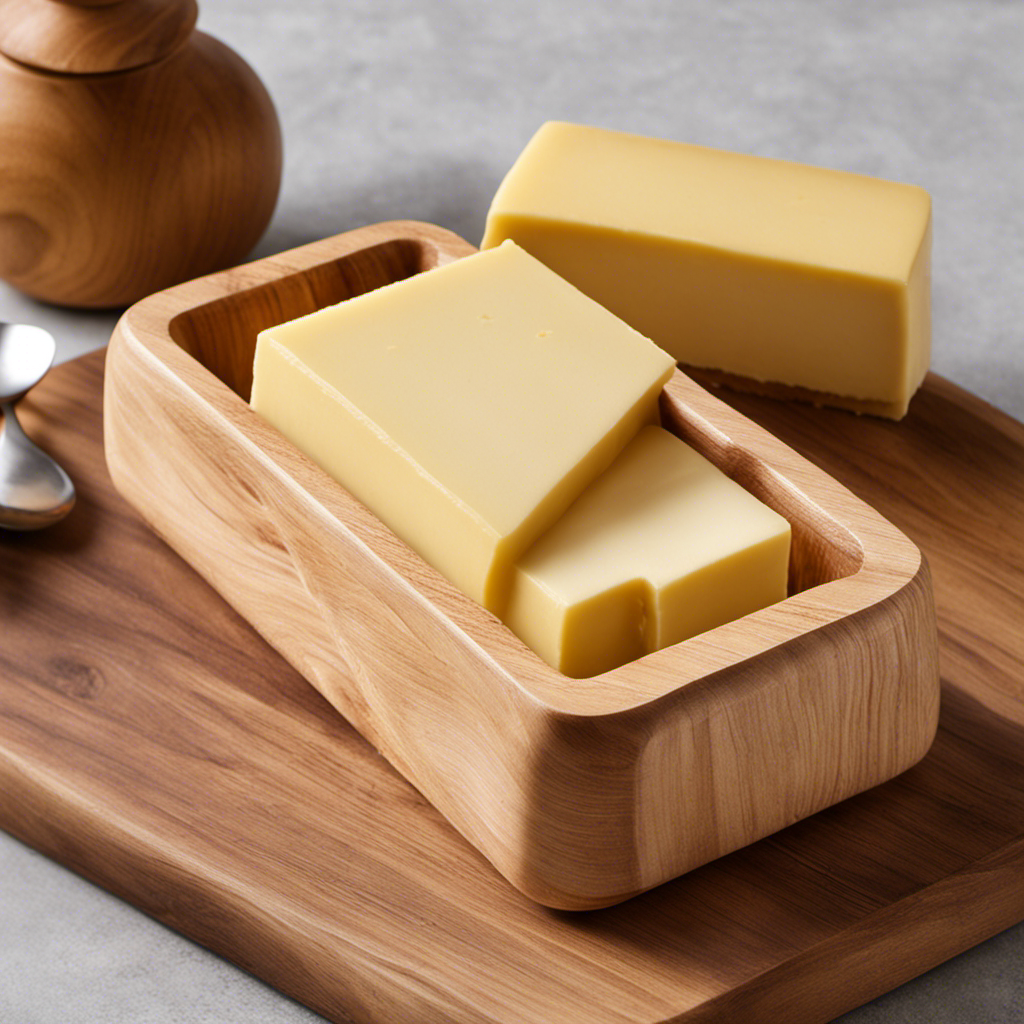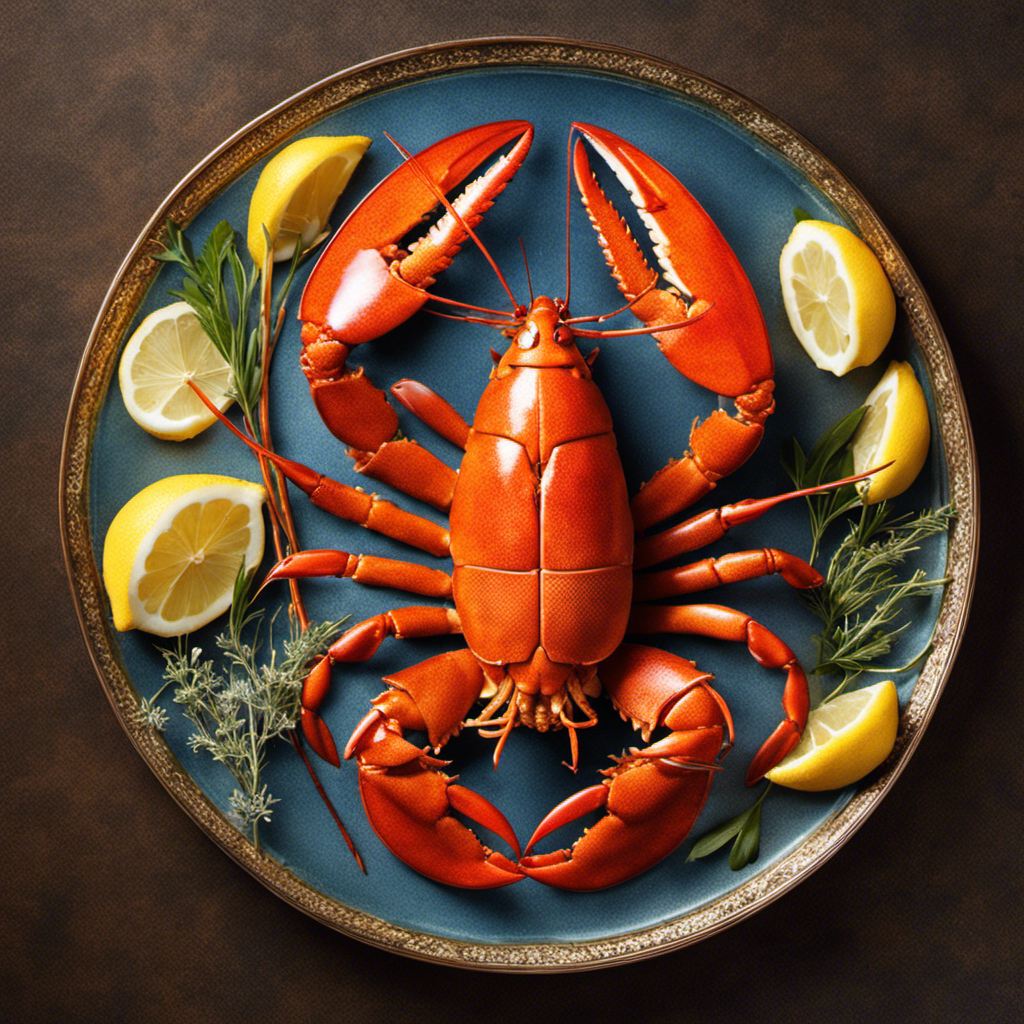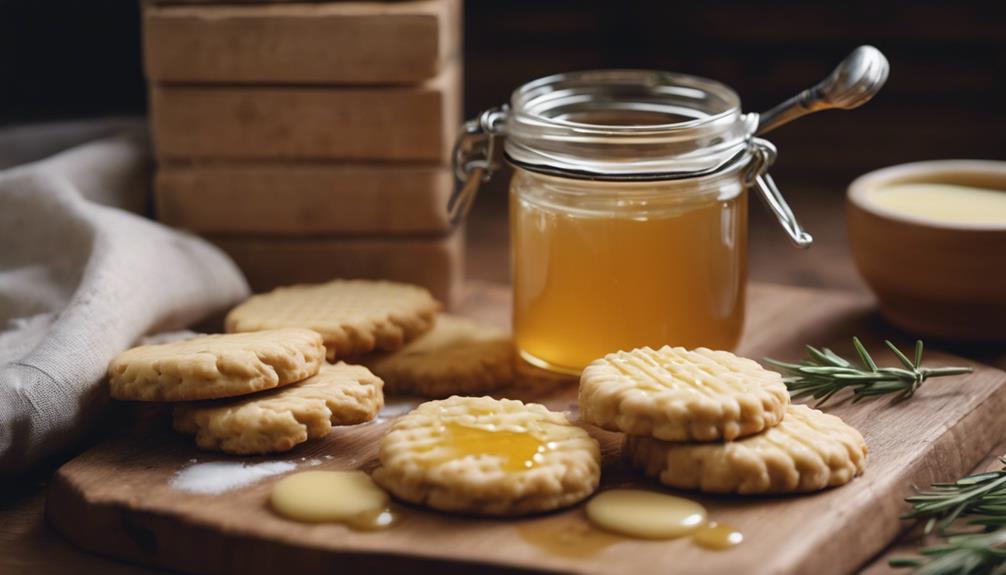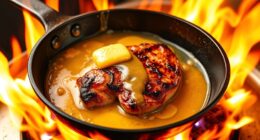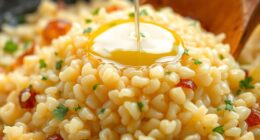As someone passionate about cooking, I frequently find myself in the kitchen questioning how many tablespoons make up a stick of butter. It’s a common inquiry that can greatly impact the result of a recipe.
In this article, we’ll dive into the ratio of tablespoons to sticks of butter, learn how to convert sticks to tablespoons, and explore the different ways to measure butter accurately.
Get ready to master the art of butter measurements and take your culinary skills to the next level!
Key Takeaways
- There are 8 tablespoons in a stick of butter.
- Cutting the stick into tablespoon-sized portions helps measure butter accurately.
- 1 stick of butter is equal to 8 tablespoons or 1/2 cup.
- Accurate butter measurements contribute to successful recipe outcomes.
The Ratio of Tablespoons to Sticks of Butter
Did you know that there are 8 tablespoons in a stick of butter?
When it comes to measuring equivalents, understanding the ratio of tablespoons to sticks of butter is crucial, especially when following recipes. Many recipes call for butter in tablespoons, while others use the measurement in sticks.
Knowing the conversion between the two can help ensure accurate measurements and successful baking results. For instance, if a recipe calls for 1 stick of butter, you can easily translate that to 8 tablespoons. Conversely, if a recipe specifies 4 tablespoons of butter, you can determine that it is equivalent to half a stick.
Understanding this simple ratio can make a significant difference in the outcome of your culinary creations. So next time you come across a recipe, keep in mind the measurement equivalency between tablespoons and sticks of butter.
Converting Sticks of Butter to Tablespoons
To convert a stick of butter to tablespoons, you’ll simply need to multiply by 8. This is because there are 8 tablespoons in one stick of butter. Converting butter measurements can be useful when following recipes or trying to determine the amount of butter needed for a specific dish.
Here are three common butter measurement equivalents to keep in mind:
- 1 stick of butter = 8 tablespoons
- 1/2 stick of butter = 4 tablespoons
- 1/4 stick of butter = 2 tablespoons
Knowing these equivalents can help you easily adjust your measurements when using different units. For example, if a recipe calls for 2 sticks of butter and you only have tablespoons available, you can simply multiply by 8 to get the equivalent amount.
Understanding butter conversions can make cooking and baking a breeze!
Determining the Measurement: Tablespoons in a Stick of Butter
When it comes to cooking and baking, knowing how to convert measurements of butter is essential.
In this discussion, we will explore the conversion of sticks of butter to tablespoons, providing you with a handy guide for your culinary endeavors.
Additionally, we will delve into the common uses for butter in various recipes, as well as suggest some substitutes for those who may be looking for healthier alternatives or have dietary restrictions.
Butter Measurement Conversion
There’s a tablespoon in every stick of butter. When it comes to measuring butter, it’s important to understand the different equivalents and conversions. Here are some key measurements to keep in mind:
-
One stick of butter is equal to 8 tablespoons or 1/2 cup.
-
If a recipe calls for tablespoons of butter, you can easily measure it by cutting the stick into tablespoon-sized portions.
-
If you need to convert tablespoons of butter into grams or ounces, the general rule of thumb is that 1 tablespoon of butter is approximately 14 grams or 0.5 ounces.
Understanding these butter measurement equivalents and conversions can help you accurately measure and use butter in your recipes. Now that you know how to measure butter, let’s explore some common uses for this versatile ingredient.
Common Uses for Butter
One way you can incorporate butter into your cooking is by using it to make a rich and creamy sauce. Butter adds a smooth and velvety texture to sauces, enhancing their flavor and richness.
However, if you are looking for butter alternatives or are concerned about the health benefits of butter, there are several options to consider.
One alternative is using olive oil or coconut oil, which can provide a similar richness and flavor to your sauces.
Another option is using plant-based margarine, which is made from vegetable oils and can be a healthier choice.
Additionally, you can experiment with using Greek yogurt or sour cream as a substitute for butter in certain recipes.
Ultimately, the choice of butter alternatives depends on your personal preferences and dietary needs.
Substitutes for Butter
If you’re looking to replace butter in your recipes, you can try using olive oil, coconut oil, or plant-based margarine as alternatives. These substitutes for butter offer various benefits, such as being lower in saturated fat, providing different flavors, and accommodating dietary restrictions.
Olive oil is a heart-healthy option that adds a rich taste to dishes. Coconut oil adds a subtle tropical flavor and can enhance the texture of baked goods. Plant-based margarine is a vegan-friendly option that can be used in equal amounts as butter in most recipes.
By using these substitutes, you can reduce your intake of saturated fat and cater to different dietary needs, without compromising on taste or texture.
Now, let’s move on to the next section about measuring butter in tablespoons versus sticks.
Tablespoons Vs. Sticks: How to Measure Butter
When it comes to measuring butter, understanding the conversion ratio is essential. The conversion ratio explains how many tablespoons are in a stick of butter, making it easier to measure accurately.
Along with the conversion ratio, there are tips for measuring butter accurately, ensuring the right amount is added to recipes.
Additionally, it’s important to be aware of the differences in butter packaging, such as sticks versus tubs, as this can affect the measurement process.
Conversion Ratio Explained
To understand the conversion ratio, you can visualize that there are 8 tablespoons in a stick of butter. This means that if a recipe calls for 1 stick of butter, you can substitute it with 8 tablespoons.
Here are a few key points to keep in mind when converting butter measurements:
-
Stick to tablespoon conversion: As mentioned earlier, 1 stick of butter is equal to 8 tablespoons. This conversion is handy when using a recipe that lists butter in tablespoons instead of sticks.
-
Converting from sticks to cups: If a recipe calls for cups of butter and you only have sticks, you can easily convert. One stick of butter is equal to 1/2 cup. So, for example, if a recipe calls for 2 cups of butter, you would need 4 sticks.
-
Precision is key: When converting butter measurements, it’s important to be precise. Using a kitchen scale can help ensure accurate measurements, especially when dealing with fractions of a stick or cup.
Measuring Accuracy Tips
Precision is crucial when measuring ingredients for baking or cooking to ensure accurate results. To help you achieve this, here are some measuring accuracy techniques and common measurement mistakes to avoid:
| Technique | Description |
|---|---|
| Use a scale | Using a kitchen scale is the most accurate way to measure ingredients. It allows you to measure by weight, which is more precise than volume measurements. |
| Level off dry ingredients | When measuring dry ingredients like flour or sugar, use a straight edge (like the back of a knife) to level off the excess, ensuring an accurate measurement. |
| Spoon and level liquids | For liquids, use a measuring spoon to scoop and level the liquid. This prevents air pockets and provides a consistent measurement. |
Common measurement mistakes include using the wrong measuring tool, such as using a tablespoon instead of a teaspoon, or not properly leveling off ingredients. These mistakes can throw off the balance of a recipe and result in undesirable outcomes. By following these measuring accuracy techniques and avoiding common measurement mistakes, you can ensure precise and successful baking or cooking results.
Butter Packaging Differences
Using a kitchen scale is the most accurate way to measure ingredients, especially when it comes to different types of butter packaging. When it comes to butter, there are various packaging options available, each with its own measurement equivalents.
Here are three common butter packaging options and their equivalents:
-
Stick Butter: This is the most common packaging option, typically sold in 1/2 cup (8 tablespoons) or 1 cup (16 tablespoons) sticks.
-
Tub Butter: Tub butter is often sold in 1 pound packages, which is equivalent to 4 sticks or 32 tablespoons.
-
European Butter: European butter usually comes in larger blocks, commonly 250 grams (about 9 ounces) or 500 grams (about 18 ounces), which can be converted to tablespoons using a conversion chart.
Understanding the different butter packaging options and their measurement equivalents is essential for accurate baking and cooking.
Now, let’s delve into understanding butter measurements in tablespoons and sticks.
Understanding Butter Measurements: Tablespoons and Sticks
Understanding the measurements of butter, there are 8 tablespoons in a stick. It’s important to understand the different measurements of butter, especially when it comes to baking and cooking. To make it easier to comprehend, let’s take a look at the table below:
| Butter Measurement Equivalents |
|---|
| 1 Stick of Butter |
| 8 Tablespoons |
| 1/2 Cup |
This table shows the equivalent measurements for a stick of butter. A stick of butter is typically packaged in a rectangular shape, wrapped in wax paper or foil. It is important to note that different countries may have slightly different measurements for butter packaging. For example, in the United States, a stick of butter is typically 1/2 cup or 8 tablespoons. However, in Europe, butter is often sold in larger blocks, usually around 250 grams. So, when using recipes from different countries, it’s important to be aware of these variations in butter packaging and measurements.
Quick and Easy Conversion: Tablespoons in a Stick of Butter
To simplify conversions, there’s typically 8 tablespoons in one stick of butter. When it comes to measuring butter accurately, it’s important to know the conversion between tablespoons and sticks. Here are some quick conversions to help you measure butter accurately:
- 1/2 stick of butter = 4 tablespoons
- 1/4 stick of butter = 2 tablespoons
- 1/8 stick of butter = 1 tablespoon
Knowing these conversions can be incredibly helpful when following recipes or when you need to quickly measure out a specific amount of butter.
Whether you’re baking a cake or making a savory dish, having this knowledge will ensure that your measurements are precise and your final product turns out just right.
Frequently Asked Questions
Can I Use Margarine Instead of Butter in Recipes That Call for a Stick of Butter?
Yes, you can use margarine instead of butter in recipes that call for a stick of butter. Margarine is a common butter substitute, but it may affect the taste and texture of your dish.
How Many Grams or Ounces Are in a Stick of Butter?
There are approximately 113.4 grams or 4 ounces in a stick of butter. It’s important to note that butter can vary in density, so it’s always a good idea to weigh it for accuracy in recipes.
What Is the Difference Between Salted and Unsalted Butter?
The difference between salted and unsalted butter lies in the addition of salt. Salted butter contains salt, while unsalted butter does not. Using unsalted butter in baking allows for more control over the saltiness of the final product.
Can I Substitute Oil for Butter in a Recipe That Calls for a Stick of Butter?
Sure, you can substitute oil for butter in a recipe that calls for a stick of butter. Some of the best oil substitutes for butter are coconut oil, olive oil, and avocado oil.
How Do I Properly Store Butter to Keep It Fresh?
Proper butter storage is crucial for preventing it from going bad. It’s important to keep butter in an airtight container, away from sunlight and heat. Refrigerating it will help extend its shelf life.
Conclusion
In conclusion, understanding the measurement of tablespoons in a stick of butter is essential for any aspiring chef. By converting sticks of butter to tablespoons, you can easily follow recipes and ensure accurate measurements.
Remember, there are 8 tablespoons in a stick of butter, making it a versatile and convenient unit of measurement in the kitchen.
So next time you’re whipping up a delicious dish, don’t underestimate the power of a stick of butter – it’s like a magic wand that adds flavor and richness to your culinary creations!
